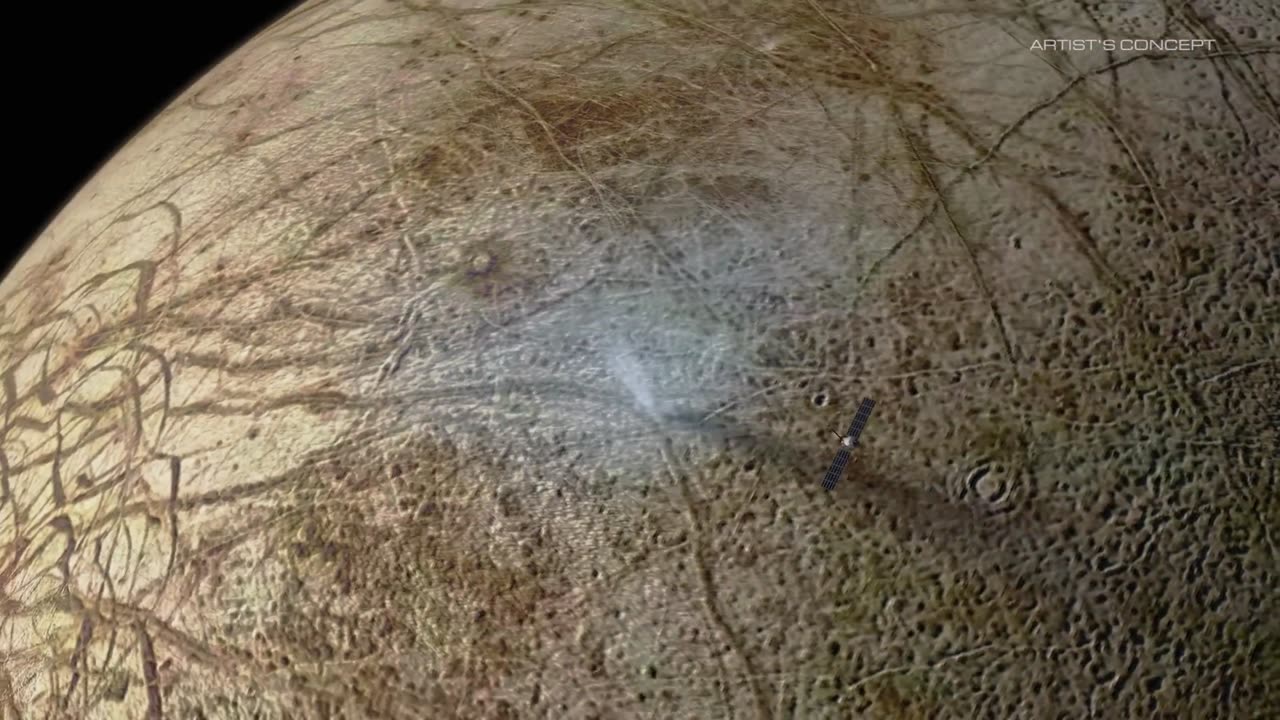Premium Only Content

Why Does NASA Want to Explore Jupiter’s Ocean Moon? (Europa Clipper Science Overview)
#europa #clipper #science #europaclipper #nasa #jupitersocean #nasaexploration #jupiterwater #nasamission #earthwater #europascience #nasascience #spacetechnology #spaceexploration #jupiter #overview #viral #trending #follow #foryou #views #rumblevideo #nasavideos
Why Does NASA Want to Explore Jupiter’s Ocean Moon? (Europa Clipper Science Overview)
Everywhere there’s water on Earth, there’s life. Does that hold true elsewhere in our solar system? NASA’s Europa Clipper mission will investigate Jupiter’s icy moon Europa, which — with its subsurface ocean — is one of the most promising places in our solar system to find environments capable of supporting life.
While Europa Clipper isn’t a life-detection mission, it will be the first to conduct a detailed survey of this icy moon to answer questions about Europa’s potential habitability and composition. The mission’s main goals are to determine the thickness of Europa’s icy shell; confirm the presence of an ocean; investigate the make-up of that ocean; and characterize the geology of the surface. The spacecraft will orbit Jupiter and make approximately 50 flybys of Europa. It’s equipped with a powerful suite of instruments that will work in sync to gather measurements and high-resolution images.
Europa Clipper is expected to launch in October 2024 from NASA’s Kennedy Space Center in Florida. It will arrive at the Jupiter system in 2030.
For more information on the mission go to: https://europa.nasa.gov/.
Credit: NASA/JPL-Caltech/APL
Why Does NASA Want to Explore Jupiter’s Ocean Moon? (Europa Clipper Science Overview)
Everywhere there’s water on Earth, there’s life. Does that hold true elsewhere in our solar system? NASA’s Europa Clipper mission will investigate Jupiter’s icy moon Europa, which — with its subsurface ocean — is one of the most promising places in our solar system to find environments capable of supporting life.
While Europa Clipper isn’t a life-detection mission, it will be the first to conduct a detailed survey of this icy moon to answer questions about Europa’s potential habitability and composition. The mission’s main goals are to determine the thickness of Europa’s icy shell; confirm the presence of an ocean; investigate the make-up of that ocean; and characterize the geology of the surface. The spacecraft will orbit Jupiter and make approximately 50 flybys of Europa. It’s equipped with a powerful suite of instruments that will work in sync to gather measurements and high-resolution images.
Europa Clipper is expected to launch in October 2024 from NASA’s Kennedy Space Center in Florida. It will arrive at the Jupiter system in 2030.
For more information on the mission go to: https://europa.nasa.gov/.
Credit: NASA/JPL-Caltech/APL
Why Does NASA Want to Explore Jupiter’s Ocean Moon? (Europa Clipper Science Overview)
Everywhere there’s water on Earth, there’s life. Does that hold true elsewhere in our solar system? NASA’s Europa Clipper mission will investigate Jupiter’s icy moon Europa, which — with its subsurface ocean — is one of the most promising places in our solar system to find environments capable of supporting life.
While Europa Clipper isn’t a life-detection mission, it will be the first to conduct a detailed survey of this icy moon to answer questions about Europa’s potential habitability and composition. The mission’s main goals are to determine the thickness of Europa’s icy shell; confirm the presence of an ocean; investigate the make-up of that ocean; and characterize the geology of the surface. The spacecraft will orbit Jupiter and make approximately 50 flybys of Europa. It’s equipped with a powerful suite of instruments that will work in sync to gather measurements and high-resolution images.
Europa Clipper is expected to launch in October 2024 from NASA’s Kennedy Space Center in Florida. It will arrive at the Jupiter system in 2030.
For more information on the mission go to: https://europa.nasa.gov/.
Credit: NASA/JPL-Caltech/APL
Why Does NASA Want to Explore Jupiter’s Ocean Moon? (Europa Clipper Science Overview)
Everywhere there’s water on Earth, there’s life. Does that hold true elsewhere in our solar system? NASA’s Europa Clipper mission will investigate Jupiter’s icy moon Europa, which — with its subsurface ocean — is one of the most promising places in our solar system to find environments capable of supporting life.
While Europa Clipper isn’t a life-detection mission, it will be the first to conduct a detailed survey of this icy moon to answer questions about Europa’s potential habitability and composition. The mission’s main goals are to determine the thickness of Europa’s icy shell; confirm the presence of an ocean; investigate the make-up of that ocean; and characterize the geology of the surface. The spacecraft will orbit Jupiter and make approximately 50 flybys of Europa. It’s equipped with a powerful suite of instruments that will work in sync to gather measurements and high-resolution images.
Europa Clipper is expected to launch in October 2024 from NASA’s Kennedy Space Center in Florida. It will arrive at the Jupiter system in 2030.
For more information on the mission go to: https://europa.nasa.gov/.
Credit: NASA/JPL-Caltech/APL
Why Does NASA Want to Explore Jupiter’s Ocean Moon? (Europa Clipper Science Overview)
Everywhere there’s water on Earth, there’s life. Does that hold true elsewhere in our solar system? NASA’s Europa Clipper mission will investigate Jupiter’s icy moon Europa, which — with its subsurface ocean — is one of the most promising places in our solar system to find environments capable of supporting life.
While Europa Clipper isn’t a life-detection mission, it will be the first to conduct a detailed survey of this icy moon to answer questions about Europa’s potential habitability and composition. The mission’s main goals are to determine the thickness of Europa’s icy shell; confirm the presence of an ocean; investigate the make-up of that ocean; and characterize the geology of the surface. The spacecraft will orbit Jupiter and make approximately 50 flybys of Europa. It’s equipped with a powerful suite of instruments that will work in sync to gather measurements and high-resolution images.
Europa Clipper is expected to launch in October 2024 from NASA’s Kennedy Space Center in Florida. It will arrive at the Jupiter system in 2030.
For more information on the mission go to: https://europa.nasa.gov/.
Credit: NASA/JPL-Caltech/APL
Why Does NASA Want to Explore Jupiter’s Ocean Moon? (Europa Clipper Science Overview)
Everywhere there’s water on Earth, there’s life. Does that hold true elsewhere in our solar system? NASA’s Europa Clipper mission will investigate Jupiter’s icy moon Europa, which — with its subsurface ocean — is one of the most promising places in our solar system to find environments capable of supporting life.
While Europa Clipper isn’t a life-detection mission, it will be the first to conduct a detailed survey of this icy moon to answer questions about Europa’s potential habitability and composition. The mission’s main goals are to determine the thickness of Europa’s icy shell; confirm the presence of an ocean; investigate the make-up of that ocean; and characterize the geology of the surface. The spacecraft will orbit Jupiter and make approximately 50 flybys of Europa. It’s equipped with a powerful suite of instruments that will work in sync to gather measurements and high-resolution images.
Europa Clipper is expected to launch in October 2024 from NASA’s Kennedy Space Center in Florida. It will arrive at the Jupiter system in 2030.
For more information on the mission go to: https://europa.nasa.gov/.
Credit: NASA/JPL-Caltech/APL
Why Does NASA Want to Explore Jupiter’s Ocean Moon? (Europa Clipper Science Overview)
Everywhere there’s water on Earth, there’s life. Does that hold true elsewhere in our solar system? NASA’s Europa Clipper mission will investigate Jupiter’s icy moon Europa, which — with its subsurface ocean — is one of the most promising places in our solar system to find environments capable of supporting life.
While Europa Clipper isn’t a life-detection mission, it will be the first to conduct a detailed survey of this icy moon to answer questions about Europa’s potential habitability and composition. The mission’s main goals are to determine the thickness of Europa’s icy shell; confirm the presence of an ocean; investigate the make-up of that ocean; and characterize the geology of the surface. The spacecraft will orbit Jupiter and make approximately 50 flybys of Europa. It’s equipped with a powerful suite of instruments that will work in sync to gather measurements and high-resolution images.
Europa Clipper is expected to launch in October 2024 from NASA’s Kennedy Space Center in Florida. It will arrive at the Jupiter system in 2030.
For more information on the mission go to: https://europa.nasa.gov/.
Credit: NASA/JPL-Caltech/APL
-
 LIVE
LIVE
LFA TV
19 hours agoLIVE & BREAKING NEWS! | WEDNESDAY 12/03/25
1,286 watching -
 1:05:46
1:05:46
The Quartering
3 hours agoNew Epstein Video Drops! The US Economy Has SCARY Numbers Released & More
102K20 -
 1:07:11
1:07:11
The White House
6 hours agoPresident Trump Makes an Announcement, Dec. 3, 2025
14.5K15 -
 LIVE
LIVE
Film Threat
22 hours agoINSIDE THE DECLINE OF DISNEY! A WARNING FROM THE PAST | Hollywood on the Rocks
201 watching -
 1:15:43
1:15:43
DeVory Darkins
4 hours agoDISTURBING: Gavin Newsom makes FATAL MISTAKE after Criminal Illegal Alien kills 11 year old boy
118K68 -
 2:53:35
2:53:35
MattMorseTV
4 hours ago $9.88 earned🔴Trump's HUGE ANNOUNCEMENT.🔴
34.6K40 -
 1:18:21
1:18:21
Sean Unpaved
5 hours agoArch Manning & Texas ELIMINATED From College Football Playoff Contention | UNPAVED
40.9K3 -
 1:59:06
1:59:06
The Charlie Kirk Show
5 hours agoBlackpilled Zoomers + Charlie's Sabbath + Minnesota Meltdown | Bowyer, Turek, Glahn | 12.3.2025
75.3K31 -
 12:44
12:44
Dr. Nick Zyrowski
2 days agoThe REAL Benefits of One Meal A Day (OMAD) Intermittent Fasting
32.1K5 -

Barry Cunningham
19 hours agoLIVE BREAKING NEWS: President Trump Addresses The Nation | Marco Rubio | Kash Patel | News!
51.8K13